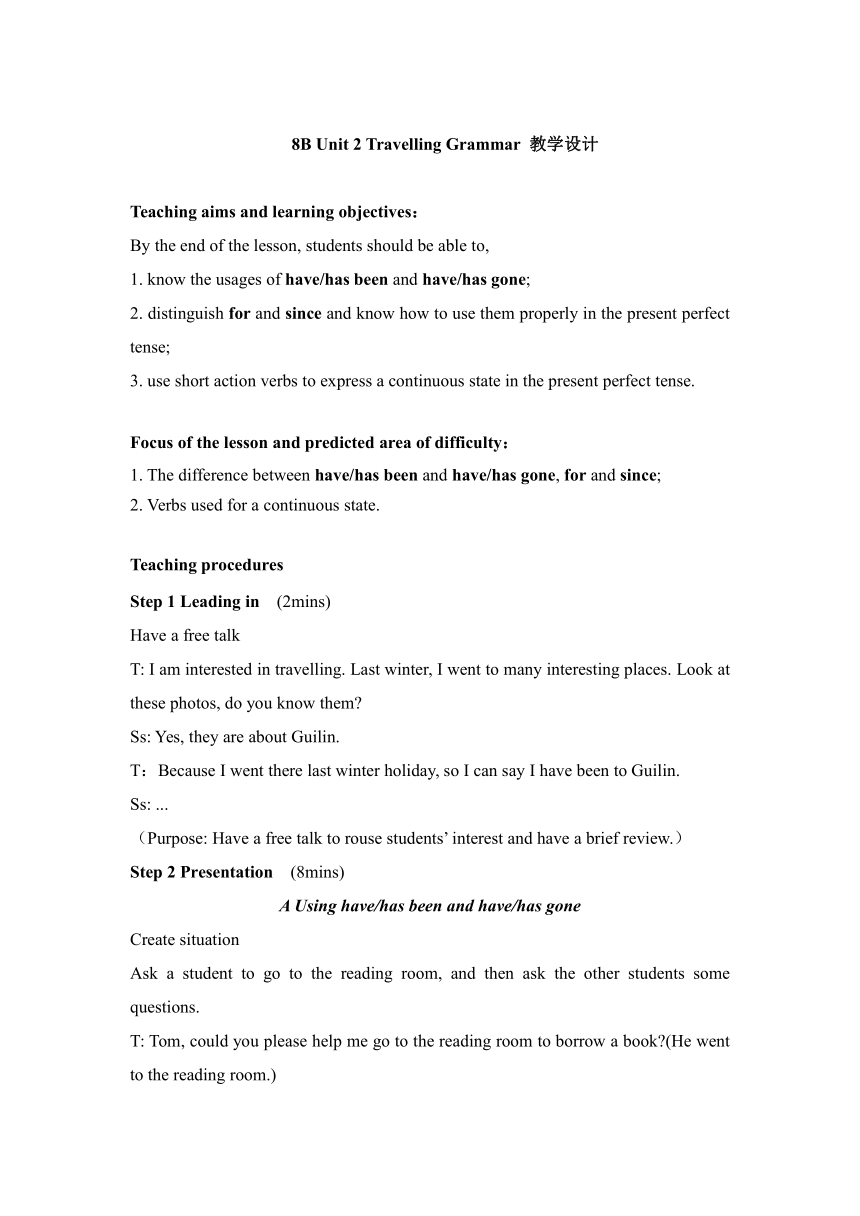
8B Unit 2 Travelling Grammar 教学设计 Teaching aims and learning objectives: By the end of the lesson, students should be able to, 1. know the usages of have/has been and have/has gone; 2. distinguish for and since and know how to use them properly in the present perfect tense; 3. use short action verbs to express a continuous state in the present perfect tense. Focus of the lesson and predicted area of difficulty: 1. The difference between have/has been and have/has gone, for and since; 2. Verbs used for a continuous state. Teaching procedures Step 1 Leading in (2mins) Have a free talk T: I am interested in travelling. Last winter, I went to many interesting places. Look at these photos, do you know them Ss: Yes, they are about Guilin. T:Because I went there last winter holiday, so I can say I have been to Guilin. Ss: ... (Purpose: Have a free talk to rouse students’ interest and have a brief review.) Step 2 Presentation (8mins) A Using have/has been and have/has gone Create situation Ask a student to go to the reading room, and then ask the other students some questions. T: Tom, could you please help me go to the reading room to borrow a book (He went to the reading room.) T: Is Tom in classroom now Ss: No, he isn’t. T: Yes. He is on the way to the reading room, or maybe he is in the reading room now and he will come back soon after. So where has he gone Ss: He has gone to the reading room. T: Good job. Do you know the differences between “have/has been to” and “have/has gone to” Task: Work out the rules T: When we want to express someone has been to some place, or he has visited a place sometime in his life, we can use“has been to” to describe an experience. But, if we use “have/has gone to” , we must remember that someone went to a place but hasn’t yet returned. Besides, we can also use “have / has been in” to express that someone was in a place for some time but now still stays there. For example: Tom has been in the reading room for five minutes. (Purpose: Creating a situation to help students understand and master the usage and differences between have/has been and have/has gone.) Step3 Practice (5mins) Task: self-study (1)Activity1 Ask students finish the exercise A1 Page26. Then check the answer and read the sentences together. (2)Activity2 Complete Part A2 Page27and check together. Finished that, invite the students to read and act out in front of class. (3)Activity3 Fill in the blanks with have/has gone to, have/has been to and have/has been in A: Where is Betty B: She _____ Europe. A: When _____ she ___ (go) there B: She _____(go) there last Sunday. And she _____ Europe for a week. A: Which is her favourite city in Europe B: The UK. A: How many times ____ she _____ The UK B: She _____ there twice. (Purpose: Apply what they have learned, complete textbook exercises independently, find deficiencies, and consolidate what they have learned.) Step4 Presentation (10mins) B Verbs with for and since (1)Discuss and di ... ...
~~ 您好,已阅读到文档的结尾了 ~~

